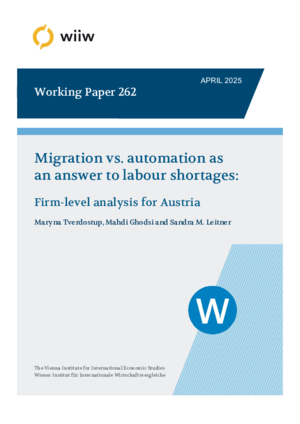Migration vs. automation as an answer to labour shortages: Firm-level analysis for Austria
Mahdi Ghodsi, Sandra M. Leitner and Maryna Tverdostup
wiiw Working Paper No. 262, April 2025
47 pages including 1 Table and 17 Figures
Labour shortages in Europe have led firms to adopt two key strategies: automation and the employment of migrants. This study empirically examines the relationship between robot adoption and immigrant labour (differentiated by region of origin and education level) in Austrian firms using a novel dataset linking firm-level survey data on robotics adoption from Austria’s Information and Communication Technologies (IKTU ) surveys (waves 2018, 2020 and 2022) with registry-based employment records. Employing Poisson pseudo-maximum likelihood (PPML) estimations, we analyse firm-level employment decisions while controlling for firm characteristics, industry and region. Our findings show that firms adopting robots tend to employ more workers overall, particularly those with low and medium education levels. Notably, robot-adopting firms employ a higher share of low-educated migrants who are not from the European Economic Area (EEA), suggesting complementarity rather than substitution. However, automation appears to reduce the employment of highly educated migrant workers relative to natives. Distinguishing between industrial and service robots, we find that service robots have a stronger association with employment growth than industrial robots. The impact of robot adoption also differs by sector and is most pronounced in manufacturing, whereas its effects vary in the private service sectors. Our findings suggest that while automation can alleviate labour shortages, it may reinforce labour market segmentation. For EU policy makers, targeted interventions are needed to support the transition of migrant workers into higher-skilled occupations and to ensure that the benefits of automation are equitably distributed. Given the EU-wide relevance of automation and migration dynamics, these results provide insights that are also applicable beyond Austria.
Keywords: Migration, automation, employment, firm- and worker-level analysis
JEL classification: D22, J23, J24, J61, O33
Countries covered: Austria
Research Areas: Labour, Migration and Income Distribution
